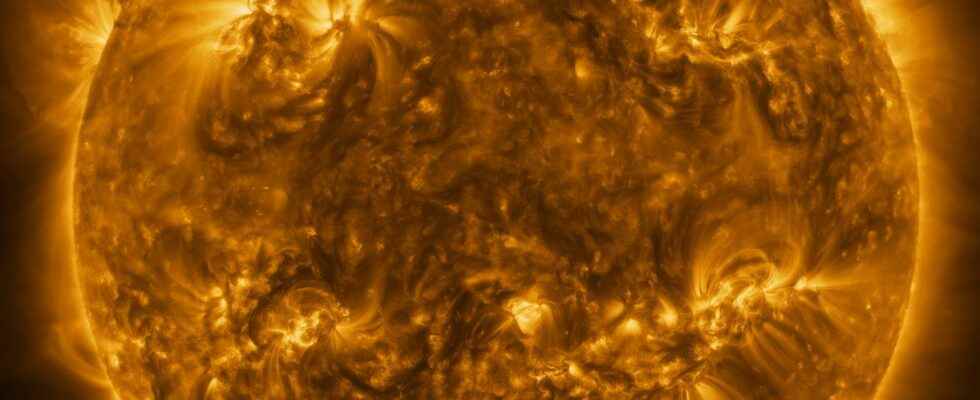They release in a few minutes 100,000 times moreenergy than all the power plants on Earth produce in a year. But above all, the solar flares sometimes wreak havoc on modern earth technologies. Airlines sometimes have to cancel flights over the poles, where communications radio are lost. In November 2015, for example, planes disappeared from radar in Sweden. In February 2022, the company SpaceX launched 49 satellites, as part of the project Elon Musk’s Starlink. Forty of them were caught in a storm geomagnetic wave caused by a solar flare, and fell back to Earth. A bitter failure that cost the company tens of millions of dollars. If theatmosphere absorbs a large part of the radiation that comes from the Sun, in powerful eruptions, many past particles make their way to us. But these eruptions follow regular cycles, of 11 years, which depend on the solar magnetic field. Today, a study published in the journal Astronomy & Astrophysics, open access article on Arxiv, offers a new method to predict their power, and therefore, better protect themselves.
The Sun’s Magnetic Field Reverses Every 11 Years
Like the Earth, the Sun has a magnetic field. It is created by what is called the solar dynamo : differences of rotation speed of several parts of the Sun, combined with a movement convection of a conductive fluid. The whole then generates a gigantic magnetosphere, that is, an area in which the influence of the magnetic field dominates physics. It is the convection movements of the solar plasma which create cycles of 11 years: the gas ionized forms convection cells, areas where it circulates in a closed circuit, and these cells move little by little from theequator towards the poles. This journey takes 11 years, and the result is a reversal of the solar magnetic field.
As to sunspotsthese correspond to areas colder than the rest of the photosphere, and are caused by the cessation of surface convection movements, following a local increase in the magnetic field. But beware, they are accompanied by a luminous halo that surrounds them and corresponds, conversely, to a warmer zone. Their diameter regularly reaches several kilometers. Then comes the eruption: a sudden release of stored magnetic energy, following a magnetic restructuring. But these magnetic phenomena do not occur symmetrically: previous studies have shown that, on the contrary, the northern hemispheres and south do not generate as many spots during a cycle.
Currently, various methods already exist to predict the intensity of a solar cycle. They connect, for example, the “rise time of the cycle to its amplitude or the polar fields to the previous minimum”, according to the study. But the best known method dates from 2020, and is based on the number of sunspots : a valuable index to assess its relevance, because readings testify to the quantity of sunspots for over 300 years. This number mainly makes it possible to deduce the power of the next cycle, so researchers assume that the current cycle started in 2020 could be particularly intense.
An average lead time of 21 months for the new method
The new method established by the scientists this time introduces “ the maximum growth rate of sunspot activity in the ascending phase of a cycle as a novel and reliable predictor of the amplitude of a subsequent solar cycle,” as detailed in the study. To establish this new relationship, the researchers relied on four data sets indicative ofsolar activity : “ the total sunspot number, hemispherical sunspot number, and total and hemispherical sunspot areas,” indicates the study. From this data, the team built a cycle amplitude prediction model and compared it to the actual data. Results, ” validation of predictions for cycles 1-24 shows high correlations between true and predicted cycle amplitudes reaching r=0.93 for total sunspot number,” details the study.
Scientists present a new method to predict the strength of the solar cycle over 11 years. © YouTube
A positive result, therefore, which also shows the importance of separation of the two hemispheres solar, and the priority consideration of the ascending phase. But also, it allows a study in real time, or almost: the researchers thus conclude on the usefulness of monitoring solar activity continuously, taking into account asymmetries. “Our work confirms the great importance of an independent study of the Sun’s hemispheres and the regular collection of data for each. It should also be noted that our method can be used in real time, we can predict the amplitude of the cycle continuously on the development of the ascending phase of a solar cycle and update the prediction when the last value of the rate of growth is greater than the previous one. With the data currently available, we expect the lower estimate of the amplitude of the current solar cycle (#25) to be 110 ± 26, which is comparable to the previous 11-year solar cycle (#24)”concludes Olga Sutyrinan, co-author of the study and research scientist at Schlumberger.
Reading ideas for the summer with Futura?
To celebrate the start of the holidays, we offer you the Mag Futura at the preferential price of 15 € instead of 19 €, i.e. a reduction of 20% !
What is Mag Futura?
- Our first paper journal of more than 200 pages to make science accessible to as many people as possible
- 4 major scientific questions for 2022, from the Earth to the Moon
- Home delivery*
*Special offer valid until July 19. Delivery is made in France (excluding metropolitan France), Switzerland, Belgium.
Interested in what you just read?
